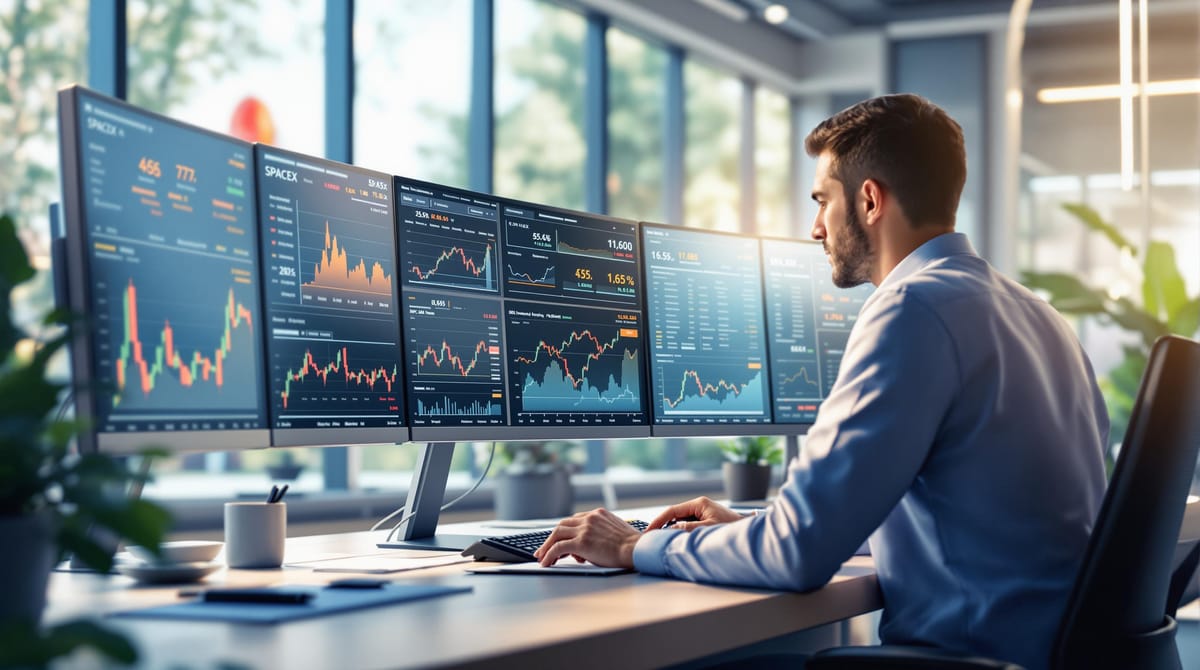Secondary Market Pricing: SpaceX Stock Insights
Explore the complexities of trading SpaceX shares on secondary markets, focusing on challenges, tools, and key trading platforms.

Secondary markets allow investors to trade SpaceX shares before it goes public. However, these markets come with challenges like limited information, price volatility, and complex processes. Here's what you need to know:
-
Key Challenges:
- Limited financial transparency since SpaceX is a private company.
- Price swings due to lower liquidity.
- High fees and strict accreditation requirements.
-
Investment Tools:
- The SpaceX Stock Investment Guide offers valuation insights, trend analysis, private market education, and access to an investor community.
-
Trading Platforms:
- Vary in fees, minimum investments, liquidity, and accreditation processes.
Takeaway: Research thoroughly, verify shares, and choose platforms carefully to navigate risks in private equity investments.
The Ultimate Guide to Investing in SpaceX

1. SpaceX Stock Investment Guide Analysis

The SpaceX Stock Investment Guide provides insights into SpaceX stock trends and strategies for pre-IPO investments. It stands out by offering straightforward guidance for navigating private markets.
The platform evaluates SpaceX's valuation and funding rounds while connecting investors through an exclusive community. This group-oriented approach, combined with detailed investment guides, makes it a helpful tool for understanding SpaceX's position in the market.
Here’s a breakdown of its key features:
| Feature | Description | Benefit |
|---|---|---|
| Valuation Insights | Detailed analysis of SpaceX's valuation and funding history | Helps clarify the company's market position |
| Stock Price Trends | Overview of price trends using secondary market data | Assists in spotting growth opportunities |
| Private Market Education | Guides and resources on private equity investments | Makes complex concepts easier to grasp |
| Investor Club | Access to a SpaceX investor community | Encourages shared insights and networking |
The platform also partners with UpMarket to expand its market analysis. Its data is particularly suited for long-term investors, addressing the common challenges of navigating private market uncertainties.
While the SpaceX Stock Investment Guide offers a solid starting point for understanding SpaceX's stock and private market trends, it’s important to combine its insights with further research to create a well-rounded investment plan.
Next, we’ll look at secondary market trading options to build on these insights.
2. Secondary Market Trading Options
Secondary market platforms allow investors to buy SpaceX shares before the company goes public. However, these platforms vary in their pricing, access rules, and regulatory processes.
Each platform has its own pricing structure, and many require strict accreditation. This often involves proving financial capability, relevant experience, and providing verified documentation. These steps are designed to meet regulatory standards.
Costs like transaction fees, management charges, and other platform-specific expenses can significantly affect the actual share price. Additionally, limited liquidity on these platforms can slow down transactions, making these factors important to consider when trading.
Trading activity on secondary platforms is influenced by things like major company news or shifts in the economy. These changes can lead to fluctuations in trading volumes and share prices. Being aware of these variables is essential before making any trades.
This sets the stage for comparing specific platforms in the next section.
Platform Comparison
Using insights from the SpaceX Stock Investment Guide Analysis, let’s break down key features of secondary market platforms. These factors can help you understand what sets different platforms apart.
- Minimum Investment Requirements: Some platforms cater to smaller investors with low entry thresholds, while others require larger investments, often tied to added services or perks.
- Fee Structures: Platforms may charge flat or tiered fees, which can impact overall trading costs.
- Accreditation and Verification: Accredited investor status is typically required, but the process for verification can differ between platforms.
- Lock-up Periods and Trading Flexibility: Holding periods and processing times vary, influencing how easily you can exit an investment.
- Liquidity: Platforms with higher trading activity often provide better market efficiency, making it easier to buy or sell shares.
For more details and educational resources, check out the SpaceX Stock Investment Guide.
These factors lay the groundwork for analyzing market performance in the next section.
Summary and Recommendations
When trading SpaceX stock on secondary platforms, it's crucial to approach the process thoughtfully. Market trends show that pricing and accessibility can vary widely across platforms, making it important to choose carefully.
Here are some practices to keep in mind:
- Do Your Homework: Check for regulatory compliance, review past transactions, confirm the authenticity of shares, and evaluate current valuations. These steps are crucial due to the risks tied to private equity investments.
- Manage Risks: Trades in private markets often face challenges like limited liquidity and inconsistent valuations. To reduce these risks, use secure transaction services, thoroughly verify shares, and carefully review platform agreements.
For more detailed guidance, explore the SpaceX Stock Investment Guide. Their comparison tools can help you match your investment choices with your goals and risk tolerance.
Comments ()